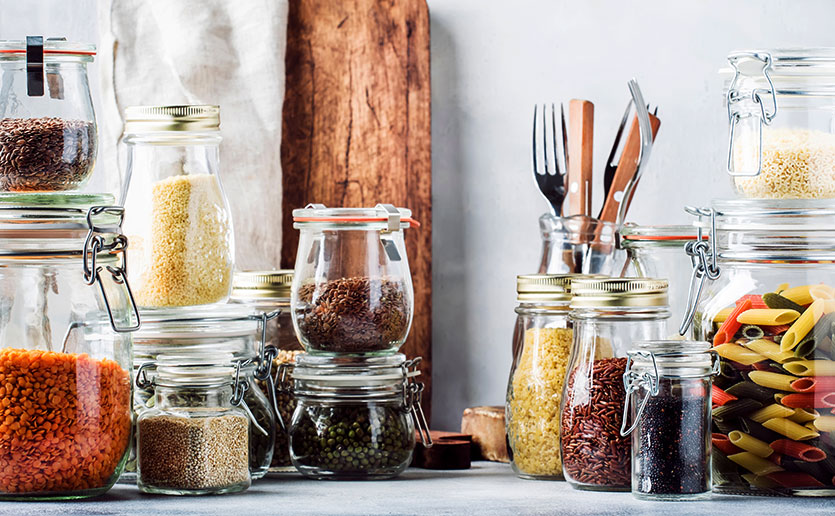While there aren’t any known foods that specifically fight COVID-19, you can support your immune system by ensuring you have beneficial ingredients available. We should be practicing physical distancing and limiting interactions with others, which includes minimizing grocery trips by maximizing our pantries.
This relies on getting a little creative in the kitchen. These tips for healthy eating will help get you started.
When creating meals without a specific recipe in mind, there is a basic formula you can use. It goes like this: starch + protein + produce + fat.
Stock COVID-19 Pantry with Starch
For most of us, the COVID-19 pandemic is simply not the time to be avoiding carbohydrates. They are an important source of energy and can easily serve as the backbone of many meals. They also offer B vitamins, necessary for supporting immune function and helping to prevent fatigue caused by certain nutrient deficiencies.
Pairing starches with protein, vegetables and fat helps to slow digestion so you get a steady supply of energy.
Starches are a significant carbohydrate to focus on because of their versatility and low perishability. Some good options to have on hand include: rice, pasta, oats, couscous, barley, bulgur and quinoa.
Pairing starches with protein, vegetables and fat helps to slow digestion so you get a steady supply of energy. This will also help stabilize blood sugar and prevent it from spiking too quickly.
Think you can’t possibly make a nutritious meal with a starch like pasta? Think again. Here’s a recipe for pasta “fazool,” which includes canned beans and Parmesan cheese (our protein); tomatoes and garlic (our vegetables); and olive oil (our fat).
Oatmeal also offers creative ways to utilize pantry staples and create balanced meals.
Combat boredom by trying these inventive oatmeal options, including some savory suggestions. Or create a grain bowl, using this reference as a guide and opting for proteins and vegetables that will last.
Proteins with Low Perishability
There are a variety of low perishable proteins to consider. They range from marine-based sources like canned tuna, salmon and sardines, to plant-based versions including canned beans, nuts (including peanut butter) and seeds (like sunflower seeds).

• Aging Well: A Diet for Your Brain
• How to Fight Anxiety with Food
• How to Detox Your Body Naturally
• Benefits of Eating Eggs
Instead of stocking up on gallons of milk, look for shelf-stable varieties (labeled as UHT) or even powdered options, which are often in the baking aisle at grocery stores.
Other refrigerated proteins such as aged cheeses (think Parmesan and sharp cheddar), unopened tofu, and eggs typically last weeks – sometimes even months – in your fridge. Check the sell by date before you buy them. (Tofu novice? Here’s a recipe.)
Don’t forget about your freezer too.
If you purchased more fresh meat than you can immediately use, freeze it (here’s a guide from the FDA). Frozen shrimp and fish are also good to keep on hand. Just remember the safest way to defrost is to do so in your fridge – not on the counter or in a bowl of warm water. This requires a little planning, but it will be helpful to think about the meals you want to make in advance to minimize food waste anyway.
A Variety of Vegetables
Vegetables tend to spoil readily, so diversify the type you are buying when shopping to prepare for COVID-19 physical distancing. If the supply in the freezer section looks sad (or nonexistent), opt for fresh options that last longer in the fridge. Try carrots, cabbage and hearty leafy greens, like kale.
Vegetables that look limp can be saved by blanching, which is essentially cooking them for a couple minutes in boiling water. You can also toss most vegetables in oil on a baking sheet and roast them in a 400-degree oven for 20 to 30 minutes until soft. (Need a recipe? Here’s one for roasted winter vegetables.) Once cooked, vegetables can be frozen and taken out as needed.
Opt for canned varieties, too. Peeled tomatoes, roasted red peppers, pickled peppers, artichokes and even sauerkraut are versatile supplies for your pantry.
Fat Means Flavor
Don’t forget to stock options like oils, salad dressing, olives and even jarred pesto (here’s a homemade recipe featuring kale). In addition to offering up immune-sustaining nutrients, like vitamin E, fat adds flavor and gets broken down into fatty acids, which help combat hunger.
So be sure to include a variety of foods to provide the energy you need over the weeks ahead. With a little creative planning, your COVID-19 pantry can offer an arsenal of supportive supplies for healthy eating.

Emily Gelsomin, MLA, RD, LDN, is a senior clinical nutrition specialist at Massachusetts General Hospital. As a registered dietitian, she counsels on medical nutrition therapy on an outpatient basis and is co-director of Be Fit, the hospital’s employee wellness program.
Jointly sponsored by The Clubs at Charles River Park and MGH Nutrition and Food Services, the 10-week program focuses on helping participants “Be Fit and Eat Right.” Every ten weeks, employees from different departments within the hospital compete with each other as they make a commitment to Be Fit. Through the creation of a social environment at the workplace, participants are supported to make progress in personal lifestyle changes with the help of a unique support system that includes a dedicated nutritionist and personal trainer.
Be Fit strives to create a milieu of wellness that extends beyond the 10-week curriculum by offering features to those who are not part of the intensive program. This includes the creation of Choose Well, Eat Well, a rating system designed to help both employees and patients increase awareness of healthy choices at retail eateries within the hospital. It also includes a monthly e-mail with a timely nutrition tip.





